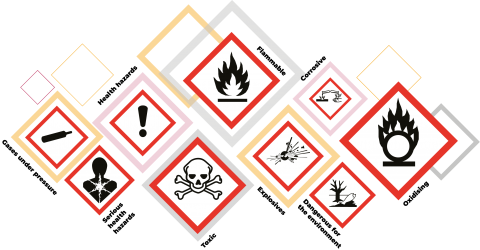

A control area is a space within a building where hazardous materials are stored, dispensed, used or handled. Control areas are constructed with features like fire rated walls that prevent the spread of fire to and from other areas in the building, allowing for safe emergency egress and fire department response. The number of control areas on a floor of a building can vary, currently ranging from one to four on a floor.
Determining MAQs is complex and relies on several structural and operational factors.
The most common factors that determine MAQs at UCM are:
► on which floor your lab is located (see Table 414.2.2 below FAQ)
► whether a fire sprinkler system is installed throughout the building
► use of approved storage cabinets
As emergency response and egress become increasingly difficult with building height, the quantity of hazardous materials that can be safely used and stored decreases. For example, the MAQs on floors 7th and above are 5% of those allowed on the 1st floor. However, if the entire building is equipped with a sprinkler system and approved storage cabinets are used, the MAQs on a specific floor can be increased from these values.
You can check the status of your MAQs compliance by logging into your chemical inventory and checking the the bottom right corner of the inventory summary page. Log in to your chemical inventory at ehs.ucop.edu/chemicals.
MAQs are set by the Fire Code to keep building occupants and first responders safe. Exceeding MAQs puts everyone at risk and is considered a serious offense. If your control area exceeds the MAQ, you will first receive an email notification with recommended corrective action. If the corrective actions cannot resolve the MAQ exceedance, EH&S will work with you and others in your area to develop a corrective action plan. Common corrective actions include decreasing the quantities of hazardous materials that you use and store, replacing old storage cabinets with approved cabinets, and in the most extreme cases, relocating research activities to another location.
Please note: Persuant to the Office of the State Fire Marshal (OSFM), a MAQ exceedance within a control area will prevent order approvals for ANY hazardous chemicals in that specific control area, not just those in the exceeded hazard class. For example, if the pyrophoric MAQ is exceeded in a control area, flammable, corrosive, or oxidizer chemical orders cannot be approved for that control area.
You can see which chemicals in your inventory belong to a specific hazard class by selecting 'Search Chemcials' in UC Chemicals and selecting the Advanced Search arrow (highlighted in red below).

Select the MAQ hazard class in the "Classification" field and the appropriate "Physical State". The search will automatically update after these selections are made.
Note that some MAQ categories (such as Oxidizers and Flammable Liquids) are split further into additional classes. Please contact EH&S to obtain a more detailed report for these classes. See this table for some common chemicals and their hazard classes.
If a MAQ exceedance is unable to be resolved, chemical order approvals of any monitored hazard class will be rejected for that specific control area and UCM is required to report the non-compliance to the Office of the State Fire Marshal (OSFM). The OSFM will determine the necessary enforcement actions which may include shutting down a laboratory, or even an entire building.
• Purchase smaller quantities of chemicals (i.e 500g instead of 1kg)
• Avoid purchasing duplicate chemicals and cases
• If possible, share chemicals (click here to see how to borrow and share a container using UC Chemicals)
• Confirm that your chemical inventory is accurate
• Dispose of any expired or unneeded chemicals and update your inventory accordingly
Since MAQs are largely determined by building construction it can be very costly to increase the limit. Due to their complexity, MAQ increases must be addressed on a case-by-case basis. Please contact EH&S for assistance.